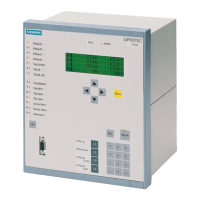Double Activation Blockage
Parallel switching operations are interlocked. As soon as the command has arrived all command objects
subject to the interlocking are checked to know whether a command is being processed. While the command
is being executed, interlocking is enabled for other commands.
Blocking by Protection
The pickup of protective elements blocks switching operations. Protective elements are configured, separately
for each switching component, to block specific switching commands sent in CLOSE and TRIP direction.
When enabled, "Block CLOSE commands" blocks CLOSE commands, whereas "Block TRIP commands" blocks
TRIP signals. Switching operations in progress will immediately be aborted by the pickup of a protective
element.
Device Status Check (set = actual)
For switching commands, a check takes place whether the selected switching device is already in the set/
desired position (set/actual comparison). This means, if a circuit breaker is already in the CLOSED position and
an attempt is made to issue a closing command, the command will be refused, with the operating message
"set condition equals actual condition". If the circuit breaker / switchgear device is in the intermediate position,
then this check is not performed.
Bypassing Interlockings
Bypassing configured interlockings at the time of the switching action happens device-internal via interlocking
recognition in the command job or globally via so-called switching modes.
•
SC=LOCAL
– The switching modes "interlocked (latched)" or "non-interlocked (unlatched)" can be set in devices
with a housing of size
1
/
2
- or
1
/
1
via the key switch. The position "Interlocking OFF" corresponds to
non-interlocked switching and serves the special purpose of unlocking the standard interlocks. For
devices in a housing of size
1
/
3
, the switching mode can be changed between "interlocked (latched)"
and "non-interlocked (unlatched)" on the operator panel after having entered the password or, by
means of CFC, also via binary input and function key.
•
REMOTE and DIGSI
– Commands issued by SICAM or DIGSI are unlocked via a global switching mode REMOTE. A separate
request must be sent for the unlocking. The unlocking applies only for
one switching operation and
for commands caused by the same source.
– Job order: command to object "Switching mode REMOTE", ON
– Job order: switching command to "switching device"
•
Command via CFC (automatic command, SC=Auto SICAM):
– Behavior configured in the CFC block ("BOOL to command").
Command Logging
During the processing of the commands, independent of the further message routing and processing,
command and process feedback information are sent to the message processing center. These messages
contain information on the cause. With the corresponding allocation (configuration) these messages are
entered in the event list, thus serving as a report.
Prerequisites
A listing of possible operating messages and their meaning as well as the command types needed for tripping
and closing of the switchgear or for raising and lowering of transformer taps are described in the SIPROTEC 4
System Description.
2.27.5
Functions
2.27 Breaker Control
SIPROTEC 4, 7SJ62/64, Manual 363
C53000-G1140-C207-8, Edition 08.2016

